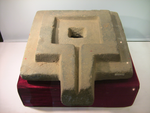Yoni
Yoni hoặc yonī, đôi khi được gọi là pindika, là một đại diện sinh thực khí (aniconic) của nữ thần Shakti trong Ấn Độ giáo.[3][4] Yoni thường được hiển thị với linga - đối tác nam tính của nó.[3][5] Cùng nhau, chúng tượng trưng cho sự hợp nhất của tiểu vũ trụ và đại vũ trụ,[5] quá trình sáng tạo và tái sinh vĩnh cửu thiêng liêng, và sự kết hợp giữa nữ tính và nam tính tái tạo tất cả sự tồn tại.[2][4] Yoni được khái niệm hóa như là cửa ngõ tự nhiên của tất cả các việc sinh, đặc biệt là trong các thực hành bí truyền Kaula và Mật tông, cũng như các truyền thống Shaktism và Shaivism của Ấn Độ giáo.[6]
Yoni là một từ tiếng Phạn đã được hiểu theo nghĩa đen là tử cung,[2][7] và các cơ quan phụ nữ.[8][9] Nó cũng bao hàm các cơ quan sinh dục nữ như "âm đạo",[4] "âm hộ",[10][11] và "tử cung",[12][13] hoặc thay vào đó là "nguồn gốc" của bất cứ thứ gì trong các bối cảnh khác.[1][4] Chẳng hạn, văn bản Vedanta Brahma Sutras ẩn dụ nói đến khái niệm siêu hình Brahman là "yoni của vũ trụ".[14] Yoni với biểu tượng linga được tìm thấy trong các đền thờ Shiva và các địa điểm khảo cổ của tiểu lục địa Ấn Độ và Đông Nam Á,[15][16][17] cũng như trong các tác phẩm điêu khắc như Lajja Gauri.[18]
Tham khảo
sửa- ^ a b Yoni Lưu trữ 2019-03-27 tại Wayback Machine, Monier Monier-Williams, Harvard University Archives, p. 858
- ^ a b c James G. Lochtefeld (2001). The Illustrated Encyclopedia of Hinduism, Volume 2. The Rosen Publishing Group. tr. 784. ISBN 978-0-8239-3180-4.
- ^ a b Rohit Dasgupta. Michael Kimmel; Christine Milrod; Amanda Kennedy (biên tập). Cultural Encyclopedia of the Penis. Rowman & Littlefield. tr. 107.
- ^ a b c d Yoni (Hinduism). Truy cập ngày 28 tháng 7 năm 2014.
- ^ a b Beltz, Johannes (ngày 1 tháng 3 năm 2011). “The Dancing Shiva: South Indian Processional Bronze, Museum Artwork, and Universal Icon”. Journal of Religion in Europe. Brill Academic Publishers. 4 (1): 204–222. doi:10.1163/187489210x553566.
- ^ Constance Jones; James D. Ryan (2006). Encyclopedia of Hinduism. Infobase Publishing. tr. 515–517. ISBN 978-0-8160-7564-5.
- ^ Indradeva, Shrirama (1966). “Correspondence between Woman and Nature in Indian Thought”. Philosophy East and West. 16 (3/4): 161–168. doi:10.2307/1397538., Quote: "Nature is my yoni (womb), [...]"
- ^ Adams, Douglas Q. (1986). “Studies in Tocharian Vocabulary IV: A Quartet of Words from a Tocharian B Magic Text”. Journal of the American Oriental Society. JSTOR. 106 (2): 339–341. doi:10.2307/601599., Quote: "Yoni- 'womb, vulva', Yoni- "way, abode' is from a second PIE root [...]";
Indradeva, Shrirama (1966). “Correspondence between Woman and Nature in Indian Thought”. Philosophy East and West. JSTOR. 16 (3/4): 161–168. doi:10.2307/1397538. - ^ Abhinavagupta; Jaideva Singh (Translator) (1989). A Trident of Wisdom: Translation of Paratrisika-vivarana. State University of New York Press. tr. 122, 175. ISBN 978-0-7914-0180-4., Quote: "yoni or womb [...]" p. 122, "[...] in the female aspect, it is known as yoni or female organ of generation [...], p. 175"
- ^ Cheris Kramarae; Dale Spender (2004). Routledge International Encyclopedia of Women: Global Women's Issues and Knowledge. Routledge. tr. 1840. ISBN 978-1-135-96315-6., Quote: "The sculpted image of the lingam (the phallus) usually stands erect in a shallow, circular basin that represents the yoni (the vulva)."
- ^ Rahul Das; Gerrit Jan Meulenbeld (1991). Johannes Bronkhorst (biên tập). Medical Literature from India, Sri Lanka, and Tibet (Volume VIII). BRILL Academic. tr. 57 note 105. ISBN 90-04-09522-5.
- ^ Louis Renou (1939), L'acception première du mot sanskrit yoni (chemin), Bulletin de la Société de Linguistique de Paris, volume 40, number 2, pages 18-24
- ^ Gerd Carling (2003). “New look at the Tocharian B medical manuscript IOL Toch 306 (Stein Ch.00316. a2) of the British Library - Oriental and India Office Collections”. Historische Sprachforschung / Historical Linguistics. 116. Bd., 1. H.: 75–95. JSTOR 40849180., Quote: "[...] diseases of the yoni (uterus and vagina) [...]";
Shivanandaiah, TM; Indudhar, TM (2010). “Lajjalu treatment of uterine prolapse”. Journal of Ayurveda and Integrative Medicine. Elsevier BV. 1 (2): 125. doi:10.4103/0975-9476.65090. PMC 3151380., Quote: "[...] vaginal-uterine disorders (Yoni Vyapat) [...]";
Frueh, Joanna (2003). “Vaginal Aesthetics”. Hypatia. Wiley. 18 (4): 137–158. doi:10.1111/j.1527-2001.2003.tb01416.x. - ^ Klostermaier, Klaus K. (1998). A Concise Encyclopedia of Hinduism (bằng tiếng Anh). Oneworld Publications. tr. 214. ISBN 978-178074-6-722.
- ^ Hugh B. Urban (2009). The Power of Tantra: Religion, Sexuality and the Politics of South Asian Studies. I.B.Tauris. tr. 2–11, 35–41. ISBN 978-0-85773-158-6.
- ^ Andrew David Hardy; Mauro Cucarzi; Patrizia Zolese (2009). Champa and the Archaeology of Mỹ Sơn (Vietnam). National University of Singapore Press. tr. 103, 157. ISBN 978-9971-69-451-7.
- ^ Donald S. Lopez (1995). Religions of India in Practice. Princeton University Press. tr. 304–307. ISBN 978-0-691-04324-1.
- ^ Carol Radcliffe Bolon (2010). Forms of the Goddess Lajja Gauri in Indian Art. Pennsylvania State University Press. tr. 40–47, 54. ISBN 978-0-271-04369-2.

